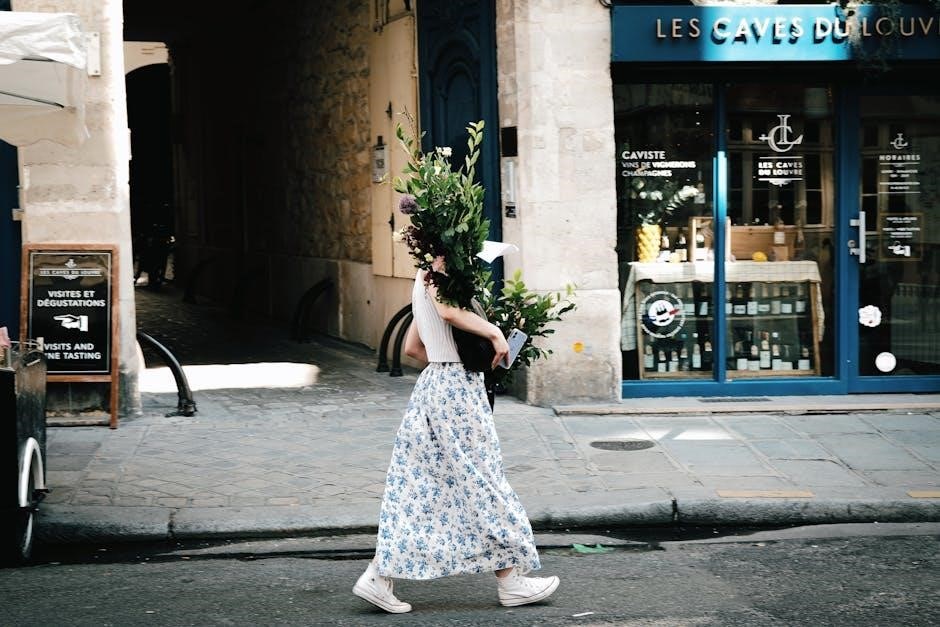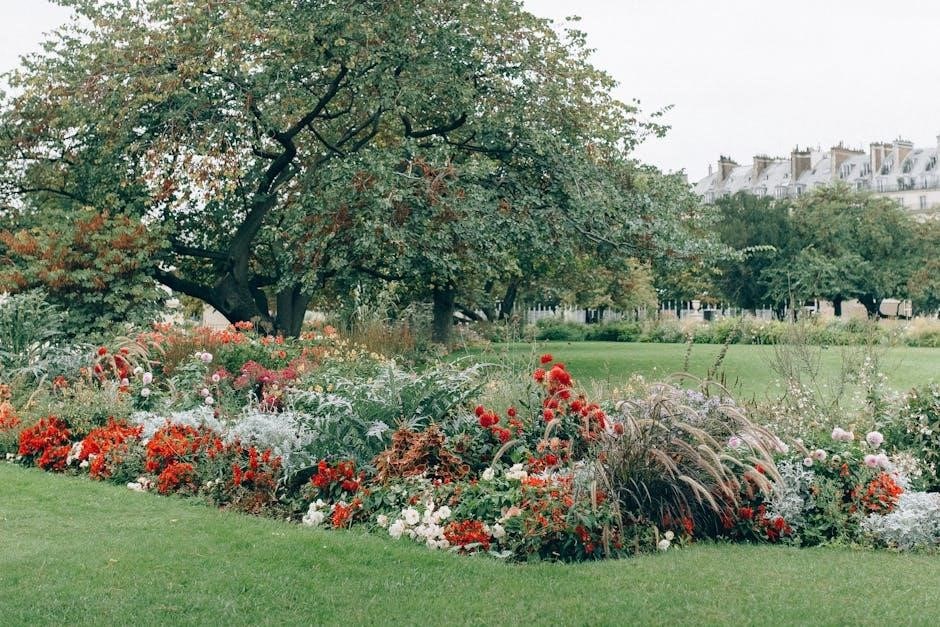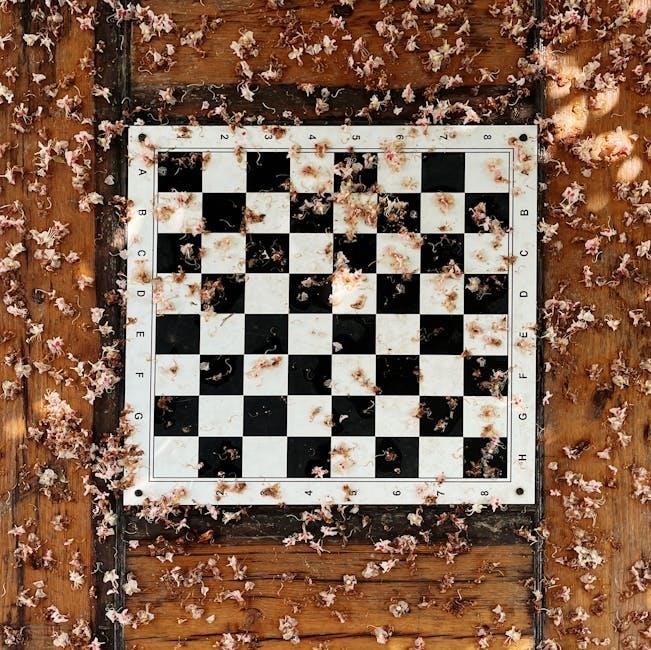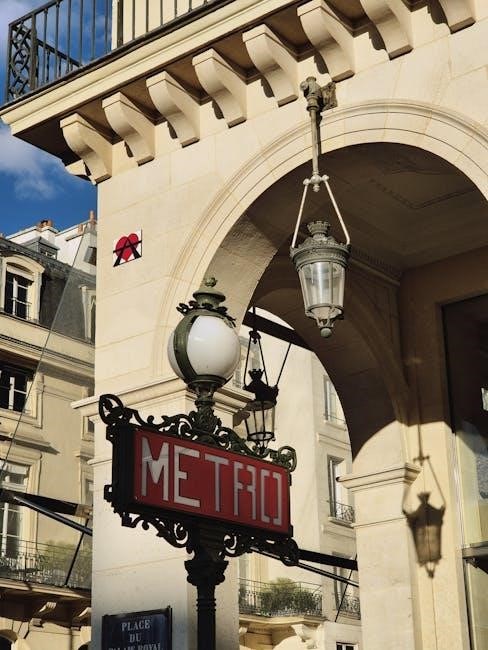Monsieur Ibrahim et les Fleurs du Coran, written by Éric-Emmanuel Schmitt, is a poignant tale of cross-cultural friendship in 1960s Paris. It follows the bond between a young Jewish boy, Momo, and Monsieur Ibrahim, a wise Arab grocer, exploring themes of identity, faith, and belonging. The novel, first published in 2001, has gained acclaim for its universal message of understanding and connection across cultural divides.
1.1 Overview of “Monsieur Ibrahim et les Fleurs du Coran”
Monsieur Ibrahim et les Fleurs du Coran is a heartwarming and thought-provoking novel set in 1960s Paris. It tells the story of Moïse, a 12-year-old Jewish boy, and his unlikely friendship with Monsieur Ibrahim, a wise Arab grocer. The narrative explores themes of identity, faith, and belonging, as Momo learns valuable life lessons from Ibrahim. The novel delves into the complexities of cultural differences while highlighting the universal human need for connection. Its poignant storytelling has made it a celebrated work, available in multiple editions, including a PDF version for modern readers.
1.2 The Author: Éric-Emmanuel Schmitt
Éric-Emmanuel Schmitt is a renowned Franco-Belgian playwright, novelist, and film director. Born in 1960, Schmitt has gained international acclaim for his works that blend philosophy, humor, and emotional depth. His plays and novels, including Monsieur Ibrahim et les Fleurs du Coran, have been translated into numerous languages and staged worldwide. Schmitt’s writing often explores themes of identity, spirituality, and human connection, making him a significant voice in contemporary literature. His ability to weave complex ideas into accessible stories has endeared him to readers and audiences globally.

1.3 Historical Context of the Novel
Set in 1960s Paris, Monsieur Ibrahim et les Fleurs du Coran captures the multicultural fabric of the city during a transformative era. The novel explores the unlikely friendship between a young Jewish boy, Momo, and Monsieur Ibrahim, an Arab grocer, highlighting the cultural and religious diversity of the time. The story reflects the social dynamics of Paris, where Jewish and Arab communities coexisted amidst post-war changes. Schmitt’s narrative bridges cultural divides, offering a poignant reflection on identity, tolerance, and understanding during a period of social evolution and immigration in France.
Main Characters
The novel centers around two main characters: Momo, a curious Jewish teenager, and Monsieur Ibrahim, a wise Arab grocer who becomes his mentor and friend.
2.1 Moïse (Momo): The Jewish Protagonist
Moïse, nicknamed Momo, is a young Jewish boy growing up in Paris during the 1960s; Struggling with identity and family challenges, Momo feels isolated and misunderstood. His curiosity and thirst for knowledge drive his journey of self-discovery. Through his interactions with Monsieur Ibrahim, Momo learns valuable life lessons that shape his perspective on religion, culture, and humanity. His transformation from a rebellious teenager to a thoughtful individual highlights the novel’s themes of growth and understanding.
2.2 Monsieur Ibrahim: The Wise Arab Grocer
Monsieur Ibrahim is a kind-hearted Arab grocer who becomes a father figure to Momo. His wisdom, patience, and deep understanding of human nature make him a central figure in the story. Originally from the Arab world, he brings a unique perspective to Paris, blending his cultural roots with French society. His calm demeanor and philosophical insights provide guidance to Momo, helping him navigate life’s challenges. Monsieur Ibrahim’s character symbolizes tolerance, wisdom, and the bridge between different cultures and beliefs.
2.3 The Relationship Between Momo and Monsieur Ibrahim
The bond between Momo and Monsieur Ibrahim evolves from a simple customer-grocer relationship into a profound friendship. Monsieur Ibrahim, with his wisdom and kindness, fills the emotional void in Momo’s life left by his distant father. Their interactions are marked by mutual respect and understanding, as Monsieur Ibrahim shares life lessons and philosophical insights. This relationship transcends cultural and religious barriers, offering Momo guidance and companionship during his formative years. It becomes a cornerstone of the story, highlighting the power of human connection.
Themes of the Novel
The novel explores themes of cross-cultural friendship, self-discovery, and religious-philosophical reflections, weaving a story of human connection and understanding across cultural and generational divides.
3.1 Cross-Cultural Friendship
The novel beautifully portrays the unlikely friendship between Momo, a young Jewish boy, and Monsieur Ibrahim, a wise Arab grocer. Their bond transcends cultural and religious barriers, showcasing mutual respect and understanding. Through their interactions, Schmitt highlights how connections between different communities can foster empathy and bridge societal divides. The friendship not only enriches their lives but also challenges stereotypes, emphasizing the universal values of kindness and acceptance. This theme remains central, illustrating the power of human connection in a diverse world.
3.2 Coming of Age and Self-Discovery
The novel explores Momo’s journey from adolescence to adulthood, highlighting his emotional and psychological growth. Through his interactions with Monsieur Ibrahim, Momo learns valuable life lessons about identity, faith, and humanity. The story captures the challenges of adolescence, including family conflicts and existential questions, as Momo navigates his Jewish heritage and the broader world. Monsieur Ibrahim’s wisdom guides Momo, helping him find his place in a complex, changing society. This theme underscores the universal struggle of self-discovery and the impact of mentorship.
3.3 Religious and Philosophical Themes
The novel delves into religious and philosophical themes, emphasizing the harmonious coexistence of Jewish and Islamic traditions through Momo and Monsieur Ibrahim’s friendship. The story explores the Quran’s teachings and Jewish philosophy, blending them to highlight universal truths about tolerance, the search for meaning, and the interconnectedness of human experiences. This blend enriches the characters’ understanding of life and identity, showcasing the power of interfaith dialogue and mutual respect.
Symbolism in the Novel
The Quran symbolizes spiritual wisdom, while Monsieur Ibrahim represents guidance and kindness. The setting of 1960s Paris reflects cultural diversity, enriching the narrative with deeper meanings.
4.1 The Significance of the Quran
The Quran in Monsieur Ibrahim et les Fleurs du Coran serves as a symbol of wisdom, guiding Momo through life’s complexities. Monsieur Ibrahim uses its teachings to impart universal truths, blending Islamic philosophy with Jewish traditions. The Quran represents a bridge between cultures, fostering mutual understanding. Its presence underscores themes of spirituality and the pursuit of knowledge. Through Monsieur Ibrahim’s interpretations, the Quran becomes a tool for Momo’s self-discovery, highlighting its enduring relevance in a multicultural world. This sacred text embodies the novel’s message of unity and shared humanity.
4.2 The Role of the “Fleurs du Coran” (Flowers of the Quran)
The “Fleurs du Coran” symbolize the essence and beauty of Islamic teachings, as Monsieur Ibrahim shares them with Momo. These metaphysical flowers represent the Quran’s spiritual and philosophical insights, transcending literal interpretation. They embody the universal truths Monsieur Ibrahim imparts, blending faith with humanism. This concept highlights the novel’s theme of cross-cultural understanding, showing how sacred texts can inspire and unite people across boundaries. The “Fleurs du Coran” become a metaphor for the shared quest for meaning and enlightenment.
4.3 Symbolism of the Setting: Paris in the 1960s
Paris in the 1960s serves as a vibrant backdrop, symbolizing cultural transformation and social change. The city’s multicultural fabric mirrors the cross-cultural friendship between Momo and Monsieur Ibrahim. The setting reflects post-colonial shifts and evolving identities, creating a space where traditions blend with modernity. The urban environment, with its diverse neighborhoods, symbolizes the characters’ journeys of self-discovery and understanding. The 1960s Paris embodies a world in transition, echoing the novel’s themes of unity amidst diversity and the quest for human connection.

Style and Structure
The narrative employs a simple yet poetic style, blending introspection with dialogue. The episodic structure focuses on key encounters, emphasizing emotional depth and philosophical reflection, creating a resonant fable-like realism.
5.1 Narrative Style and Perspective
The novel is written in a simple, poetic style, reflecting the innocence and curiosity of its young narrator, Moïse. The first-person perspective creates an intimate connection, allowing readers to experience Moïse’s emotional journey and philosophical awakening. Schmitt’s prose is both accessible and profound, blending humor and wisdom. The narrative flows naturally, capturing the evolving relationship between Moïse and Monsieur Ibrahim. This storytelling approach emphasizes themes of identity, faith, and human connection, making the novel both engaging and thought-provoking. The perspective also highlights the cultural and spiritual exchanges that shape Moïse’s understanding of the world.
5.2 Use of Dialogue and Character Development
The novel employs dialogue to reveal character traits and deepen relationships. Conversations between Moïse and Monsieur Ibrahim are rich in wisdom and humor, showcasing their bond and mutual respect. Through their exchanges, Moïse’s curiosity and Ibrahim’s sage advice are highlighted, driving the narrative forward. The dialogue often touches on cultural and religious themes, adding depth to the characters’ interactions. The balance between dialogue and descriptive passages provides insight into the characters’ emotions and backgrounds, creating a dynamic and engaging storytelling experience. This approach allows readers to witness Moïse’s growth and the profound impact of Ibrahim’s mentorship.

5.3 The Blend of Fable and Realism
The novel masterfully combines elements of fable and realism, creating a unique narrative style. While the story is set in a realistic 1960s Parisian neighborhood, it incorporates a fabulist tone through Monsieur Ibrahim’s wisdom and the symbolic “Fleurs du Coran.” This blend allows the narrative to feel both grounded and timeless, offering universal lessons about life, culture, and spirituality. The interplay between the everyday struggles of Moïse and the mystical teachings of Ibrahim creates a captivating balance that enriches the storytelling and deepens the emotional impact of the novel.

Adaptations and Interpretations
The novel has been adapted into a film and interpreted through various cultural perspectives, showcasing its universal themes and timeless appeal.
6.1 The Film Adaptation: “Monsieur Ibrahim”
Directed by François Dupeyron, the 2003 film adaptation brings the novel to life, starring Omar Sharif as Monsieur Ibrahim and Pierre Boulanger as Momo. The movie captures the heartwarming bond between the two characters, exploring themes of friendship, identity, and intercultural understanding. Filmed in Paris and Turkey, it maintains the essence of Schmitt’s narrative while adding visual depth. The film was well-received, particularly in France, and helped broaden the novel’s international audience. Its success lies in its faithful adaptation and emotional resonance.
6.2 Director François Dupeyron’s Vision
François Dupeyron’s direction masterfully captures the emotional depth of the novel, focusing on the transformative bond between Momo and Monsieur Ibrahim. His vision emphasizes the universality of human connection, blending Parisian culture with elements of Arab heritage. Dupeyron’s sensitive storytelling highlights the characters’ inner journeys, weaving together moments of humor, tenderness, and philosophical reflection. His approach ensures the film remains true to the novel’s spirit while offering a visually poignant interpretation that resonates with audiences worldwide.
6.3 Omar Sharif’s Portrayal of Monsieur Ibrahim
Omar Sharif’s portrayal of Monsieur Ibrahim brings profound warmth and depth to the character, infusing him with a quiet wisdom and gentle authority. Sharif’s performance captures the essence of Ibrahim’s philosophical musings and paternal affection for Momo. His ability to convey the character’s inner richness and cultural depth earned widespread acclaim, making his depiction a memorable highlight of the film. Sharif’s interpretation remains faithful to the novel while adding a unique charm that enhances the story’s emotional resonance.

Cultural and Social Impact
The novel bridges cultural divides, fostering interfaith dialogue and understanding. Its portrayal of minority communities highlights their contributions to society, encouraging empathy and inclusivity worldwide.
7.1 Bridging Cultural Divides

The novel serves as a powerful bridge between cultures, highlighting the transformative power of interfaith and interracial relationships. Through Momo and Monsieur Ibrahim’s bond, it challenges stereotypes and fosters mutual understanding. Set in 1960s Paris, the story reflects the city’s cultural melting pot, emphasizing the importance of empathy in breaking down social and religious barriers. By humanizing characters from diverse backgrounds, the book encourages readers to embrace differences and value shared humanity, making it a timeless tool for promoting unity in a divided world.
7.2 Representation of Minority Communities
The novel provides a heartfelt portrayal of minority communities, particularly the Jewish and Arab populations in Paris. Monsieur Ibrahim, as a wise Arab grocer, and Momo, a young Jewish boy, embody the richness of their respective cultures. Their stories challenge stereotypes and offer authentic representations, fostering understanding and empathy. The novel sheds light on the struggles and contributions of minority groups, celebrating their unique identities while highlighting their shared humanity; This representation enriches the narrative, making it a valuable exploration of diversity and inclusion in society.
7.3 The Novel’s Reception in France and Beyond
The novel received widespread acclaim in France for its poignant storytelling and universal themes. Critics praised its ability to bridge cultural gaps, resonating with readers from diverse backgrounds. Internationally, the book gained popularity, especially after the film adaptation, and has been translated into multiple languages. Its exploration of human connections and intercultural understanding made it a beloved read globally. The novel’s success lies in its ability to transcend borders, both geographically and culturally, making it a cherished work of contemporary literature.

Educational Significance
The novel is widely taught in schools for promoting intercultural dialogue, exploring identity, and fostering tolerance, making it a valuable educational resource for students navigating a diverse world.
8.1 Teaching the Novel in Schools
Teaching Monsieur Ibrahim et les Fleurs du Coran in schools fosters intercultural dialogue and moral reflection. The novel’s themes of friendship, identity, and tolerance resonate with students, encouraging empathy. Its accessible language and universal messages make it suitable for diverse classrooms. Educators use the story to explore cultural differences and promote understanding. The PDF version of the book is often utilized for easy access, allowing students to engage with the text digitally. This approach enhances learning and facilitates meaningful discussions about unity and acceptance in a globalized world.
8.2 Themes for Classroom Discussion
The novel offers rich themes for classroom discussion, such as cross-cultural friendship, identity, and religious tolerance. Students can explore Momo’s journey of self-discovery and the moral lessons taught by Monsieur Ibrahim. The story’s emphasis on empathy and understanding encourages discussions about diversity and inclusion. Teachers can also highlight the universal values of kindness and respect, fostering a deeper appreciation for different cultures and beliefs. These themes promote critical thinking and open dialogue in an educational setting.
8.3 The Novel’s Contribution to Intercultural Education
By exploring themes of cross-cultural understanding, the novel bridges gaps between Jewish and Arab communities. It fosters empathy and mutual respect, highlighting shared human values. The story’s universal messages make it a powerful tool for intercultural education, encouraging students to embrace diversity. Monsieur Ibrahim’s wisdom and Momo’s growth illustrate the importance of dialogue and openness. This contributes to a richer understanding of different cultures and religions, making it a valuable resource for promoting tolerance and harmony in educational settings.

Editions and Publications
Available in various formats, the novel’s PDF version ensures global accessibility. It has become a popular choice for readers, enhancing the book’s reach and convenience worldwide.
9.1 The Original French Edition
The original French edition of Monsieur Ibrahim et les Fleurs du Coran was published in 2003 by Albin Michel. This edition remains a cornerstone for readers, preserving the novel’s cultural and linguistic essence. Its success in France led to translations worldwide. The PDF version of this edition is widely sought after, offering a convenient way to access the story while maintaining the original text’s integrity. It has become a popular choice for both French-speaking readers and learners of the language.

9.2 Translations and International Availability
The novel has been translated into multiple languages, including English, Spanish, Italian, and Arabic, broadening its global reach. These translations have made the story accessible to diverse audiences, fostering cross-cultural understanding. The PDF version of these translations is widely available online, allowing readers worldwide to engage with the text conveniently. This accessibility has contributed to the book’s popularity and its ability to resonate with readers across different linguistic and cultural backgrounds.
9.4 The PDF Version and Digital Accessibility
The PDF version of Monsieur Ibrahim et les Fleurs du Coran is widely available online, offering readers a convenient way to access the novel. Digital platforms like eBooks and online libraries provide easy downloads, ensuring the story reaches a global audience. The PDF format preserves the original text’s integrity, making it accessible on various devices. This digital accessibility has made the book more approachable, especially for younger readers and those in regions where physical copies are scarce, fostering a broader connection with the narrative.
The novel remains a timeless tale of cross-cultural friendship and philosophical insight, offering readers a profound message of unity and understanding across generations and backgrounds.
10.1 The Timeless Relevance of “Monsieur Ibrahim et les Fleurs du Coran”
The novel’s exploration of cross-cultural friendship, self-discovery, and philosophical truths continues to resonate with readers today, offering timeless lessons on unity and understanding.
Its universal themes transcend generations, making it a cherished read for audiences seeking stories of human connection and spiritual growth.
The emotional depth and simplicity of the narrative ensure its relevance, inspiring reflection on diversity, identity, and the power of relationships to transform lives.
10.2 The Legacy of the Novel
“Monsieur Ibrahim et les Fleurs du Coran” has left a lasting impact on literature, celebrated for its heartfelt storytelling and universal themes.
The novel’s legacy lies in its ability to foster intercultural understanding, making it a beloved work in both French and global literary landscapes.
Its influence extends beyond the page, inspiring adaptations and sparking meaningful discussions about identity, faith, and human connection.
10.3 Final Thoughts on the Book’s Message
“Monsieur Ibrahim et les Fleurs du Coran” delivers a profound message about the power of human connection and cross-cultural understanding.
Through Momo and Monsieur Ibrahim’s bond, the novel highlights how shared experiences and wisdom can transcend religious and cultural divides.
It reminds readers of the importance of empathy, self-discovery, and the universal truths that unite us, leaving a lasting impact on all who encounter the story.
